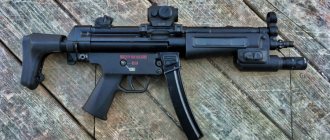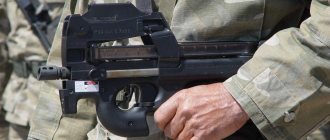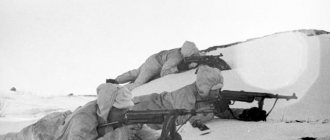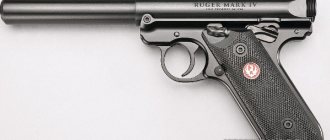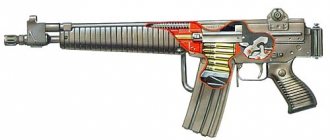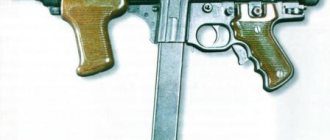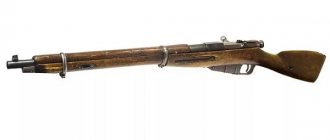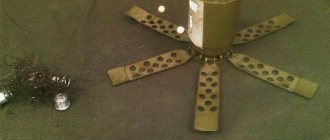| Villar-Perosa OVP M1918 | |
| Type | submachine gun |
| A country | Italy |
| Service history | |
| Adopted | 1918 |
| Wars and conflicts | World War I |
| Production history | |
| Constructor | Bethel Abiel Revelli |
| Designed by | 1914 |
| Manufacturer | RIV[d] |
| Characteristics | |
| Weight, kg | 3,26 |
| Length, mm | 850 |
| Barrel length, mm | 305 |
| Cartridge | 9×19 mm Glisenti |
| Caliber, mm | 9 |
| Work principles | semi-blowback |
| Rate of fire, rounds/min | 900 |
| Initial bullet speed, m/s | 320 |
| Sighting range, m | 1800 |
| Type of ammunition | 25-round box magazine |
| Media files on Wikimedia Commons | |
Villar-Perosa OVP M1918
is a 9 mm Italian submachine gun.
History[edit | edit code]
The Villar-Perosa M1915 submachine gun was originally designed by designer Revelli in 1914 to arm airplanes, but the too weak 9-mm Glizenti pistol cartridge used in this model made this submachine gun ineffective in air combat. In 1915, the new system was turned into a kind of ultra-light machine gun, making it the world's first submachine gun.
This bulky weapon, which consisted of a pair of two receivers with separate magazines located on top and a common trigger with a trigger, which had an exceptionally high rate of fire - 3000 rounds per minute (1500 per barrel), belongs to full-fledged submachine guns in the modern meaning of the word. , perhaps a controversial issue. However, towards the end of the war, a completely traditionally designed and looking PP was created on its basis - the Beretta M1918 of the Tulio Marengoni system. It was essentially one of the Vilar-Perosa receivers, supplemented by a conventional trigger with a trigger and installed in a wooden carbine stock. However, there is also information that the Beretta M1918 was a self-loading carbine, deprived of the ability to conduct automatic fire; Probably, we can talk about the existence of two different weapon options.
After the end of the war in the 1920s, the “sparky” remaining in the warehouses (a small number) were also mainly converted into more practical single-barreled SMGs - Villar-Perosa OVP M1918 (Officcine di Villar Perosa), which received a rifle stock and a conventional trigger with a trigger crochet.[1][2]. OVP had limited use during the war with Ethiopia, as well as in North Africa during World War II
Family of submachine guns Villar-Perosa (Italy)
The First World War led to the emergence of a mass of different classes of weapons and military equipment. Subsequently, some samples of that time became a kind of classics and the basis for new developments, but their creation was associated with a lot of problems, and was also accompanied by the appearance of many not very successful designs. Some new designs were of interest from a technical point of view, but still did not have significant prospects. One example of such weapons can be considered the Italian family of Villar-Perosa submachine guns. A hundred years ago, gunsmiths did not have modern knowledge and experience, which led to interesting results. Thus, the weapons of the Villar-Perosa family were initially positioned as a machine gun, but were supposed to use a pistol cartridge. Thus, according to modern classification, this weapon belongs to the class of submachine guns. At the same time, however, a number of characteristic features proposed by the authors of the project implied the use of weapons “like a machine gun.” As a result, the original submachine gun was, so to speak, more of a machine gun than a pistol.
The Villar-Perosa project started in 1914. Soon after the start of fighting in Europe, the Italian officer Bethel Revelli, who already had experience in the development of small arms, proposed an original weapon design for aircraft. According to the officer's idea, the airplanes of the Italian army should be armed with movable turrets with new machine guns of his design. To simplify the design and improve performance, a system was proposed, consisting of two independent blocks with their own automation units and using a pistol cartridge. Soon after the design was completed, the new weapon was presented to the military.
Villar-Perosa M1915 machine gun body. Photo: Wikimedia Commons
The proposed aircraft turret machine gun was of some interest, but still did not suit the military. The main complaint against it was the relatively weak 9x19 mm Glisenti pistol cartridge. Such ammunition had a relatively light bullet, and also provided an initial speed of no more than 300-320 m/s. As a result, the effective range of fire and the power of bullets left much to be desired and did not allow one to count on the complete destruction of enemy aircraft or balloons. Thus, the machine gun designed by B. Revelli was not suitable for installation on aircraft. Subsequently, Italian aviation received other weapons with higher performance.
The capabilities of the new machine gun were not suitable for aviation, but it could find use in the ground forces. In 1915, a new version of the weapon appeared, adapted for use in the army. This modification of the machine gun was named Villar-Perosa M1915 and was able to quickly reach mass production. The main features of land battles made it possible to ignore a number of features of the machine gun that had previously prevented its use in aviation.
One of the main objectives of the original project was to achieve the highest possible rate of fire, due to which it was planned to ensure acceptable combat characteristics. Not wanting to use new untested ideas and solutions, B. Revelli proposed making a new machine gun in the form of two interconnected units with their own automation on each. This design was supposed to be a reasonable compromise between complexity and high performance.
The Villar-Perosa M1915 machine gun was based on two basic blocks, each of which was an independent submachine gun chambered for the Glisenti cartridge. This weapon had a receiver in the form of a round tube with several slots and windows. The barrel bushing was placed at the front end of the tube; behind it there were windows for the magazine (top) and for ejecting cartridges (bottom). On the right surface of the box there was a complex-shaped groove for the bolt handle. There was a bend in the front part, the remaining sections were straight. At the bottom rear of the tube there was a slot for elements of the trigger mechanism. Finally, the open rear end of the box was closed with a lid combined with handles.
Machine gun on a tripod. Photo: Forgottenweapons.com
Inside the receiver there was a massive cylindrical bolt with a firing pin and means for extracting cartridges. A charging handle was attached to the side of the bolt. In the extreme forward position, the bolt was held using a return spring, which occupied the entire rear part of the receiver.
The ammunition supply of such a unit was to be carried out using detachable box magazines placed in the upper window of the receiver. Using a spring, the cartridges had to be fed to the movable bolt, after which it would independently send them into the chamber. Spent cartridges were ejected automatically through a window in the lower part of the receiver.
The Villar-Perosa M1915 product had an automatic mechanism based on a semi-blowback, and the units of the two “halves” of the weapon were in no way connected to each other. Under the influence of the return spring, the bolt had to move from the rearmost position to the front, capturing a cartridge from the magazine and sending it into the chamber. In the extreme forward position, a shot was fired, after which the bolt began to move in the opposite direction. At the initial stage of movement back, the bolt was slowed down due to the interaction of the handle and its groove in the receiver. The front inclined part of the groove caused the bolt to rotate and thereby reduce its speed. The final braking was performed by a spring. In the rearmost position, the shutter was fixed with a sear entering through a slot in the bottom of the box.
The upper part of the receivers and magazine receiving windows. Photo: Forgottenweapons.com
An increase in the rate of fire was achieved not only through the use of a twin design, but also through the correct ratio of the mass of the bolt and the rigidity of the recoil spring. Due to the lightweight bolt and stiff spring, the “half” of the machine gun could fire at a rate of up to 1,500 rounds per minute. The overall rate of fire of the entire system, accordingly, reached 3 thousand rounds per minute.
In the M1915 modification, two basic units were connected into a single structure using a pair of main parts. A massive metal washer with two holes was put on the barrels, and a complex-shaped part was attached to the rear parts of the receivers. In the front part there were two cylinders that served as receiver covers, and the rear part was made in the form of two vertical handles, similar to those used on machine guns of that time. Two L-shaped swinging levers, responsible for fire control, were attached to this part. The upper end of the lever was made in the form of a trigger button, and the lower end was used as a sear and was supposed to hold the bolt in the rear position. When the trigger was pressed, the sear moved down and released the bolt. Two levers with buttons had to interact with two basic units, which made it possible to fire both simultaneously from two barrels, and alternately from one or the other.
Between the triggers there was a fuse in the form of a T-shaped part. When turned on, the fuse did not allow the triggers to move and thereby blocked the descent. When rotated at an angle of about 90°, the lower rocker arm of the safety allowed the levers to swing normally and fire shots.
For greater convenience of working with weapons, when connecting two separate units, a device for simultaneous reloading was installed on them. It consisted of two curved levers connected by a common axis. The axis was located on the bottom of the receivers. When one of the levers was turned, both handles were shifted back, which led to synchronous cocking of both mechanisms. If necessary, it was possible to cock the bolts separately, using only their own handles.
Handles and triggers. Photo: Forgottenweapons.com
The sights of the Villae-Perosa M1915 machine gun consisted of a front sight and rear sight. The front sight was mounted on a part connecting the two barrels, and the rear sight was located on the rear block with fire control handles. Depending on certain features of the weapon, the design of the sighting devices could change. However, in all variants, the double-barreled submachine gun had only one set of sighting devices.
The infantry machine gun was not too heavy - about 6.5 kg without additional equipment. However, it was initially proposed to use it only in conjunction with special machines. A lightweight metal tripod was developed that allowed the weapon to be placed on the ground or other support, and a special wooden frame-pallet for the tripod was also offered. An additional armored shield with a window for aiming could be mounted in front of the weapon receivers.
Over time, the production of wooden rifle-type stocks with a butt was mastered. Such a product was attached to the body of the machine gun without any modifications and, as proposed, made it possible to fire not only from a rest position, but also on the move. However, the proposed “manual” version of the machine gun had a characteristic drawback in the form of ambiguous ergonomics. To fire from two barrels at the same time, you had to hold the weapon by the handles with both hands and at the same time press the trigger buttons.
M1915 machine gun on a machine with a pallet. Photo: World.guns.ru
The Villar-Perosa M1915 submachine gun received military approval and already went into production in 1915. The low mass of weapons with relatively high fire characteristics attracted the attention of the command of some army structures. As a result of this, the vast majority of new machine guns were sent to mountain rifle and assault units, which required light, simple, but effective weapons.
The new weapon allowed Italian soldiers to effectively attack and hit the enemy at distances of up to several hundred meters (the stated target range of fire was 1800 m), literally showering them with bullets. The high rate of fire, at the level of 3000 rounds per minute, was useful in a number of situations, but often led to increased ammunition consumption. Because of this, over time, a method of using weapons was formed, which was later used by all machine gunners. Two basic units with their own mechanisms and barrels should have been used alternately. This made it possible to halve the consumption of ammunition without an unacceptable reduction in firepower, and also facilitated firing with minimal interruptions. Having emptied one magazine, the shooter could shoot from the second unit. At the same time, the second crew number could change the empty magazine, which made it possible to use the first barrel again after the cartridges in the second magazine were used up.
In various modifications, differing in additional equipment, Villar-Perosa M1915 machine guns were actively used by the Italian army until the very end of the First World War. This weapon performed well in battles, as it had noticeable advantages over other small arms.
The shooter uses a machine gun on a tripod with a shield. Photo: Forgottenweapons.com
Despite all the positive qualities, the B. Revelli submachine gun had a number of specific shortcomings that negatively affected its practical use. The main one was the excessive rate of fire. In the case of aircraft weapons, the ability to fire at a rate of up to 3 thousand rounds per minute was justified, but for infantry it was redundant and unprofitable in terms of ammunition consumption and the weight of the required ammunition. In addition, the architecture of a weapon with two independent basic units, which increased the rate of fire to meaningless values and led to a noticeable increase in the weight of the entire structure, was also considered inappropriate.
It was decided to rework the existing machine gun and create on its basis a full-fledged small arms for infantry, suitable for carrying and more convenient use. This modification was called Villar-Perosa OVP M1918. The basis for the new weapon was taken from one of the basic units of the machine gun, which lost some parts and received some new ones. For example, the sights were moved from individual parts to the barrel and receiver, and the rear cover of the box was replaced with a new one. The bolt and recoil spring were also modified. The purpose of such modifications was to reduce the rate of fire to an acceptable level.
A new unit had to be attached to the existing cylindrical receiver, which contained the elements of the firing mechanism. This product was a metal cylindrical casing that was placed on the back of the existing receiver. Inside there were several parts, including a sear, a fuse and the mechanisms of two triggers. To simplify the design of the trigger, different hooks had to be responsible for single and automatic fire. A wooden rifle-type butt with a pistol lug was attached to the back of the new product.
General view of the Villar-Perosa OVP M1918 submachine gun. Photo: Wikimedia Commons
This design redesign made it possible to dramatically reduce the weight of the weapon. The body of the M1915 double-barreled machine gun without additional equipment weighed about 6.5 kg, while the weight of the OVP M1918 (without ammunition) was only 3.6 kg. Thanks to the new bolt and spring, the rate of fire did not exceed 900 rounds per minute, which ensured an acceptable ratio of firepower and ammunition consumption.
The upgraded Villar-Perosa OVP M1918 submachine guns were produced from scratch and were also manufactured by converting existing M1915s. The rearmament of the army began at the end of the 1990s, soon after the appearance of the new design. Single-barreled submachine guns of the new model were one of the main types of weapons in Italy for two decades, until the outbreak of World War II. Over time, these weapons were partially replaced by newer models, but still continued to be actively used by the army.
According to some sources, Italy planned to sell Villar-Perosa M1915 machine guns to third countries. Approximately in 1915-17, a modification of this weapon was created chambered for the .455 Webley cartridge, which was offered to Great Britain. A number of these machine guns were transferred to the British military for testing. Weapon inspections did not lead to the conclusion of a contract, and one of the sent machine guns later became a museum exhibit.
During the First World War, weapon designs now considered classic either did not exist or were just being developed. As a result, a large number of samples of original appearance and architecture appeared, which could hardly be developed now. However, many such strange systems went into mass production and were used by the armies of different countries. One example of this was the Villar-Perosa M1915 machine gun. In addition, this weapon became an interesting example of how a not very successful design ultimately turns into a full-fledged weapon with good characteristics. From the point of view of ease of use and combat qualities, the modernized OVP M1918 was much better than its predecessor, and in addition, it already had great similarities with later successful submachine guns.
Based on materials from the sites: https://world.guns.ru/ https://forgottenweapons.com/ https://armoury-online.ru/ https://eragun.org/
Design[edit | edit code]
Structurally, they consisted of a barrel removed from the spark plug with the trigger removed and placed in a rifle stock; the same cartridge was used. Due to the separation of the barrels, the rate of fire was halved, but it was nevertheless equal to almost 900 rounds per minute, but a second trigger appeared behind the first, which made it possible to change the fire mode by selecting the appropriate one. Both systems - the Beretta and the Vilar-Perosa - had bolt retarders designed to reduce the rate of fire to reasonable limits for hand-held weapons - about 900 rounds per minute. The OVP used a semi-free bolt, the retreat of which was slightly slowed down by turning at a small (about 45 degrees) angle due to the interaction of its special protrusions with the screw grooves on the inner surface of the receiver.
Design[edit]
The Villar Perosa was designed as a portable double-barreled machine gun that fired 9mm rounds. It consisted of two independent twin guns, each with its own barrel, firing mechanism and separate magazine for 25 rounds.
Because it was originally designed for use from aircraft, it had a high rate of fire of over 1,500 rounds per minute. However, in practice, the 9mm ammunition was not powerful enough to shoot down aircraft, which became increasingly resistant as the war progressed, and also had an insufficient range.
It was also used during World War I by Italian infantry with a bipod and gun shield. Despite the high rate of fire, atypical design and weight, it turned out to be very effective at short distances. [1]
Recommendations
- ^ a b c
Nicole, David (25 March 2003).
Italian Army of the First World War
. Action 387. Osprey Publishing. paragraph 33. ISBN 9781841763989. - Landships II, https://www.landships.info/landships/weapon_articles.html?load=weapon_articles/Villar_Perosa.html
- "Villar Perosa." Retrieved December 6, 2015.
- Anthony G. Williams (2012). The Submachine Gun: The Development of Submachine Guns and Their Ammunition from World War I to the Present
. Crowwood Press UK. p. 260. ISBN 978-1847972934.
Links[edit]
- ^ a b c
Nicole, David (25 March 2003). Italian Army of the First World War. Action 387. Osprey Publishing. paragraph 33. ISBN 9781841763989. - Landships II, https://www.landships.info/landships/weapon_articles.html?load=weapon_articles/Villar_Perosa.html
- "Villar Perosa". Retrieved December 6, 2015.
- Anthony G. Williams (2012). The Submachine Gun: The Development of Submachine Guns and Their Ammunition from World War I to the Present
. Crowwood Press UK. p. 260. ISBN 978-1847972934.
